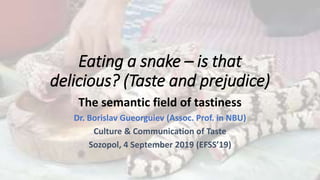Eating a snake - is that delicious? (Taste and Prejudice)
- 1. Eating a snake ŌĆō is that delicious? (Taste and prejudice) The semantic field of tastiness Dr. Borislav Gueorguiev (Assoc. Prof. in NBU) Culture & Communication of Taste Sozopol, 4 September 2019 (EFSSŌĆÖ19)
- 2. Video & Movies ŌĆó https://www.youtube.com/watch?v=5OP6NaMF4UE ŌĆó The snake dinner: https://www.youtube.com/watch?v=3MgyRO3c870 ŌĆó Exploring all our fears and prejudices.
- 3. ŌĆó How we define what is tasty? How we define what is delicious? How we define what is disgusting? ŌĆó By exploring the semantic field of tastiness through mapping. ŌĆó In our days due to the globalization the world cuisine is multicultural, and the notion of tastiness is very confused and vague, even fuzzy. So, we must define strictly the meanings of the basic binary oppositions formatting that semantic field of testiness as tasty/not tasty, pleasant/unpleasant (disgusting), soft/hard (chilly), tough/tender etc.
- 4. What is a semantic field? Adrienne Lehrer has defined semantic field more specifically as "a set of lexemes which cover a certain conceptual domain and which bear certain specifiable relations to one another". A conceptual domain is the representation of any coherent segment of experience, such as love and journeys in studies of metaphor. A conceptual domain that is understood in terms of another is called a conceptual metaphor.
- 5. How we define a semantic field? ŌĆó By inductive or by deductive way. ŌĆó Inductive way ŌĆō by a corpora of words, more or less synonymous or antonymous. ŌĆó Deductive way ŌĆō by a set of binary oppositions presupposed to be relevant for the semantic field: good/evil, East/West etc.
- 6. Roman Jakobson All five external senses carry semiotic functions in human society. About taste:ŌĆ”the selection, succession, and grading of courses and drinks for taste. (ŌĆ£Language in relation to other communication systemsŌĆØ)
- 7. Sign systems, based on seven strategic types of communication 1. Touch: hot/cold; soft/hard; pleasant/unpleasant (disgusting), 2. Smell: soft/hard; pleasant/unpleasant; ŌĆ£Perfume: The Story of a MurdererŌĆØ ( Patrick S├╝skind) 3. Taste: raw (le cru)/cooked (le cuit) ŌĆō Claude L├®vi-Strauss; sweet/bitter; soft/hard (chilly), tough/tender; tasty/not tasty, pleasant/unpleasant (disgusting), 4. Hearing: loud/quiet; articulate/non-articulate; pleasant/unpleasant (disgusting), 5. Sight (Vision): clear/cloudy; articulate/non-articulates 6. Oral: loud/quiet; articulate/non-articulate; instantaneousness/continuity 7. Written: clear/cloudy; articulate/non-articulate; instantaneousness/continuity
- 8. pleasant ŌĆō unpleasant (disgusting) known ŌĆō unknown domestic - savage safe ŌĆō dangerous order ŌĆō chaos reason - prejudice porc - snake








